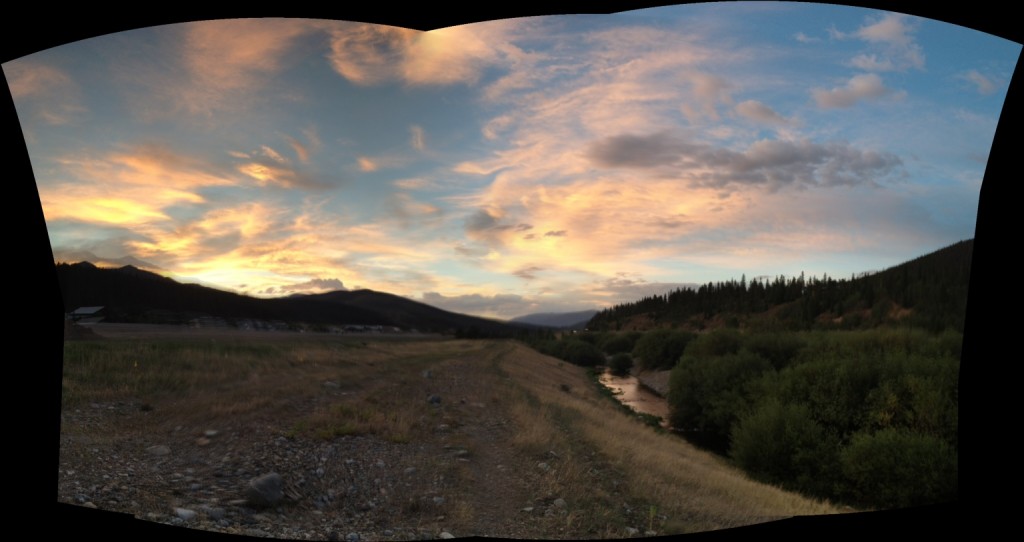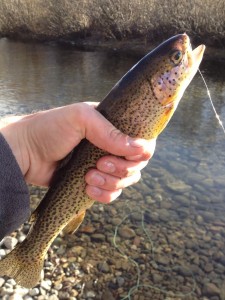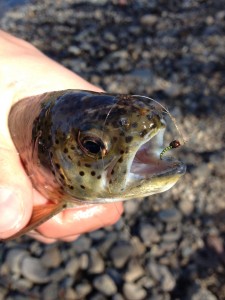
Everyone has a place they go to unwind, and mine, currently, is a spot on the Blue River that I have dubbed the “Honey Hole.” The name comes from a place that I once visited with my father when I was extremely young. So young, in fact, that it is one of those memories that is barely a memory at all; not much more than a couple of mental snapshots hanging on the edge of the abyss of forgetfulness. This memory is so blurred that I might even need to double check with my father at some point to confirm that it even happened. In any event, my memory of the honey hole comes from Missouri where I spent the first few years of my young life. It was a wooded area, there were old, rustic cabins scattered about, and most importantly, there was a creek. Within this creek, there was a deep hole where many fish, their type unbeknownst to me, gathered. I recall using small pieces of pink bait, shaped something like an oversized fish egg, and that’s about it. I do not know how long I was there, or whether or not my father and I even caught any fish, but I do know that this place was the honey hole, named as such for the abundance of easily landed fish. My present honey hole is much more memorable. 
The Blue River, stemming from the Blue Lakes, runs right through the heart of Breckenridge. At its source, it’s nothing more than a creek, tumbling over rocks, weaving through fields of willows, wildflowers, and tall grasses, and at one point taking a brief hiatus in a large pond. By the time it reaches town just 9 or 10 miles later, it’s a full sized stream, finding its way around mountain homes and businesses. At the north end of town, the Blue slows down a touch and meanders through a long stretch of completely restored trout habitat. Shallow pools, each roughly a long cast in length, are connected by short waterfalls. Halfway through this restored habitat, there is an area where the stream splits. It is not, however, a noticeable fork in the stream. From one of the deeper pools, water percolates through porous gravel and pops out again, like a spring, a short ways off course from the main flow. It reminds me of the “Business Loop” one might see branching off of a major interstate. This side creek is much smaller in volume than the main stream. It, too, babbles through a series of much smaller steps and pools, crashing through dense stands of willows and shrubs. The vegetation in most parts of this side stream is so impenetrable that fishing is largely impossible, unless you think you have the wits to grab a trout with your bare hands. At the very end of this detour, the water picks up speed and tumbles through an even thicker stand of vegetation. The willows form a sort of tunnel over the stream where little light penetrates, and the water runs black. Many insects buzz around the tangled branches, and many of them end up being swept down stream. Then, as quickly as the new creek started, it flows from the dark tunnel and dumps into a small, sunlit pool. This is the honey hole. The water slows rapidly to a crawl and widens to about 15 feet. At it’s center, the honey hole is maybe knee deep. Fry, the tiniest of trout, dart in and out of small rocks in the shallows, while smaller adults swim lazily near the rear of the pool. Moving upstream from one end of the pool to another (a total of roughly 50 feet), the fish get bigger and bigger. On occasion, I have snagged my fly rig on willow branches near the mouth of the pool where the water rushes from the tunnel, turning from black to crystal clear again. Wading cautiously towards that transitionary spot to remove the fly from the tree, I have seen several monstrous trout hunkered down under low hanging branches, in the dark, preying on insects that get trapped in the current further upstream. Most nights that I visit the honey hole, I spot many fish, though most of them are quite small. Not once have I approached this spot to find another fisherman already taking up the space. It’s a small haven on a heavily fished section of water.
 For a time, the honey hole got on my nerves. When I first started fly fishing and discovered the spot, I had no waders. I would timidly waltz into the hole, positioning myself to cast upstream towards the far end, while my feet quickly turned numb and took on a mild blue hue. To further aggravate the situation, I was nowhere near talented enough to avoid getting snagged on the willows that closely hugged the water. Each trip somehow ended in mild bursts of frustration, even if I caught a couple of trout. Eventually I mastered casting through the small trees. I usually stand near the center of the honey hole with about twenty feet of line extending from the tip of my rod. Lifting my arm sends the line soaring backwards up over my head. For what feels like an extended second, the line continues to float away from me, downstream. When I feel it go taught, a quick flick of the wrist brings everything whizzing forward, cutting through the air next to my ear. The line forms a tight loop, and my fly floats through the air, just above the water and just barely below the scraggly branches, before plopping effortlessly at the head of the honey hole and floating slowly, naturally, back towards me. Sometimes the process is repeated a seemingly indefinite number of times before I might eventually feel a trout on the end of my line. Regardless of how long it might take to land one, if at all, the honey hole always makes me feel refreshed. And even though I don’t always catch one of the numerous fish, the picture is always the same: the sun sets over the 10 Mile Range to the west, and cold, crystal clear water curves around my calves while beautiful trout coast slowly by.
For a time, the honey hole got on my nerves. When I first started fly fishing and discovered the spot, I had no waders. I would timidly waltz into the hole, positioning myself to cast upstream towards the far end, while my feet quickly turned numb and took on a mild blue hue. To further aggravate the situation, I was nowhere near talented enough to avoid getting snagged on the willows that closely hugged the water. Each trip somehow ended in mild bursts of frustration, even if I caught a couple of trout. Eventually I mastered casting through the small trees. I usually stand near the center of the honey hole with about twenty feet of line extending from the tip of my rod. Lifting my arm sends the line soaring backwards up over my head. For what feels like an extended second, the line continues to float away from me, downstream. When I feel it go taught, a quick flick of the wrist brings everything whizzing forward, cutting through the air next to my ear. The line forms a tight loop, and my fly floats through the air, just above the water and just barely below the scraggly branches, before plopping effortlessly at the head of the honey hole and floating slowly, naturally, back towards me. Sometimes the process is repeated a seemingly indefinite number of times before I might eventually feel a trout on the end of my line. Regardless of how long it might take to land one, if at all, the honey hole always makes me feel refreshed. And even though I don’t always catch one of the numerous fish, the picture is always the same: the sun sets over the 10 Mile Range to the west, and cold, crystal clear water curves around my calves while beautiful trout coast slowly by.
.jpg)
